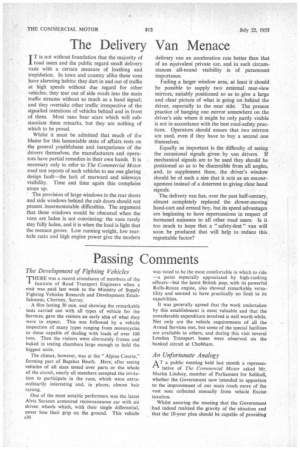Passing Comments
Page 32

Page 33

If you've noticed an error in this article please click here to report it so we can fix it.
The Development of Fighting Vehicles
THERE was a record attendance of members of the Institute of Road Transport Engineers when a visit was paid last week to the Ministry of Supply Fighting Vehicles Research and Development Establishment, Chertsey, Surrey.
A film lasting 30 min. and showing the remarkable tests carried out with all types of vehicle for the Services, gave the visitors an early idea of what they were to expect. This was followed by a vehicle inspection of many types ranging from motorcycles to those capable of dealing with loads of over 100 tons. Then the visitors were alternately frozen and baked in testing chambers large enough to hold the biggest units.
The climax, however, was at the "Alpine Course," forming part of Bagshot Heath. Here, after seeing vehicles of all sizes tested over parts or the whole of the circuit, nearly all members accepted the invitation to participate in the runs, which were extraordinarily interesting and, in places, almost hair raising.
One of the most notable performers was the latest Alvis Saracen armoured reconnaissance car with six driven wheels which, with their single differential, never lose their grip on the ground. This vehicle
was voted to be the most comfortable in which to ride —a point especially appreciated by high-ranking off-leers—but the latest British jeep, with its powerful Rolls-Royce engine, also showed remarkable versatility and seemed to have practically no limit to its capabilities.
It was generally agreed that the work undertaken by this establishment is most valuable and that the considerable expenditure involved is well worth while. Not only are the vehicle requirements of all the Armed Services met, but some of the special facilities are available to others, and during this visit several London Transport buses were observed on the banked circuit at Chobham.
An Unfortunate Analogy
AT a public meeting held last month a represen tative of The Commercial Motor asked Mr. Martin Lindsay, member of Parliament for Solihull, whether the Government now intended to apportion to the improvement of our main roads more of the vast sum collected annually from vehicle Excise taxation.
Whilst assuring the meeting that the Government had indeed realized the gravity of the situation and that the 10-year plan should be capable of providing suitable trunk communications between large towns, Mr. Lindsay could sec no reason why a large proportion of the tax should be allocated to road improvements.
To illustrate his point he raised the subject of the duty on beer, which, he maintained, could scarcely be expected to be spent on providing better public houses. This analogy is hardly logical, however: what the beer drinker pays in tax is equivalent only to what the road user pays in fuel tax. Publiezhouse improvements are paid for out of the brewers' profits and at present it is the Government who are making a profit out of the roads, with little corresponding plough-back for the betterment of them.
Obliterations—Not Slashes
TIPPER-DECK passengers on a Nottingham City ••••# Transport bus proceeding to the Royal Show were somewhat puzzled by an, apparently official notice above the off-side front seats. It read: "River Below—Please Do Tap Feet." A closer inspection revealed that certain of the letters had been scraped or otherwise blotted out and the correct injunction was: "Driver Below—Please Do Not Stamp Feet."
Whilst somewhat amusing, such misplaced humour on the part of childish passengers—old or young—is very annoying to operators, although not ranking so low as the slashing of seat material which sometimes occurs.
CIAT Aids a Visitor
QNE of the greatest road passenger transport organizations in the world is the Compagnia Italiana Autoservizi Turistici, formerly known almost universally as C1T, with head offices in the Piazza Esedra, Rome, and others throughout Italy and in many countries abroad.
The company's bus and coach services link up almost every part of Italy and the Europabus service there is also operated by CIAT.
However, it is the personal experience of the good service afforded to a member of our staff by this great company which is the main topic of this paragraph. He mentioned to the London office of CIAT that he was visiting Italy. This information was conveyed to Rome and the CIAT representative at the small town of Abano, to which he first proceeded, was instructed to contact him at his hotel. Later, when he arrived with a small party at Rome, he was received by a uniformed CIAT officer with car and conveyed to his hotel.
Each morning and afternoon, a collecting coach arrived to take the party and others to the Piazza Esedra, from which various tours started. People of many nationalities joined these, but they were rapidly sorted out by language and conducted by highly qualified guides who displayed an excellent knowledge of the numerous monuments and places of historic or artistic interest.
A final appreciated gesture was to convey the party to the station for the return journey to England.




































































































